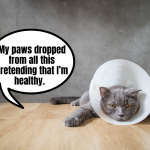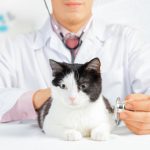Just like humans, cats can also suffer from all sorts of allergies that are an excessive reaction of the immune system, for example, to an ingredient in food or fleas, mites or pollen. The consequences of exposure to these agents can affect the health of some purriers. The most common allergy is a food allergy often confused with intolerance. Its symptoms may be similar to other diseases, making it difficult to diagnose and therefore not easy to cope with.
Most often the cat reacts badly to products of origin:
– animal products (beef, fish, chicken meat);
– cereals (mainly gluten);
– dairy products;
– soybean;
– certain species of fish;
– eggs.
For example, our team Kitty is allergic to beef and chicken. It took almost a year to treat the kitten. She’s been through a lot of research and testing. Luckily, she was able to get out of the way thanks to a strict diet. We had to limit ourselves to giving the monoprotein lamb that saved Kittie.
Sometimes it can be that it’s not a particular food that causes an allergy in your cat, but the chemistry contained in its preservation or toasting (artificial dyes and flavours, thickeners, etc.) The same goes for the meat itself – especially the very cheap one – it can have so much allergenic chemistry (e.g. antibiotics) that cat disease is guaranteed. Unfortunately we – “human” – we’re also sick because of this. After all, “you are what you eat”, Hippocrates wrote.
Our cat can also react badly to dry food because of the mites that are on its surface.
An allergy doesn’t have to accompany a purr from the first weeks of life – it can happen even when the cat is an adult. It’s worth knowing this and being alert throughout the life of our fur. Paying attention to the quality of the food and its composition can also help, because with a better composition, we have more
the chance that at least the chemical additives will not be as much as in a very cheap food substitute.
The symptoms of food allergy in a cat
The most common symptom of food allergy in a cat is severe itching. In addition, skin changes such as redness, urticaria, scabs and dandruff may appear on your cat’s skin. These symptoms are most often confused with atopic dermatitis and parasitic infections. Allergic cats often shake their heads and lick their feet, often leading to baldness. Due to the strong skin reaction, swelling on the muzzle of the purr may occur and the quality of the coat may be significantly reduced. Futer women who eat something that causes them allergies often also suffer from bilateral inflammation of ears, lips, paw pads and peri-reversible glands. Cats tired of feeling unwell also become apathetic. If you notice such symptoms in your furry friend, don’t hesitate to go to the vet to find out what’s causing your purring.
Typical symptoms of a food allergy are:
- Skin problems – severe itching and redness, hives, dandruff, scabs, areas of baldness or even skin damage
- Recurrent ear infections
- Deterioration of the coat
- The severity of the hairball problem
- In rare cases, breathing or coughing problems.
Sherlock Holmes in action, which means we diagnose a food allergy
We begin to diagnose a cat’s food allergy by excluding all other conditions that may be similar. Only this will allow us to properly diagnose what our kitten is suffering from. Although some veterinarians are undertaking tests for allergy in cats, it is increasingly common to hear that they are not entirely reliable. How can you find out what’s wrong with your furry friend? Go to the dermatologist’s office and be patient. Unfortunately, making a diagnosis can take a long time.
In some cases, the only solution is to see a dermatologist.
When the doctor suspects an allergy, he will ask you what your cat is eating and what supplements or treats it may be getting. The most important things in this case are
product compositions, because on their basis you can start distinguishing possible allergens. In breeding cats, it may be helpful to know whether the ancestors of the cat had an allergy to some component of their diet and whether it is not a genetic allergy (e.g. Siamese cats are more susceptible to allergies than other breeds). It is good to know that such a congenital allergy most often manifests itself in cats quite early (between 6 months and 3 years of age).
Further steps in our diagnostic procedure – we introduce an elimination diet. We give our cat foods that have what a purr hasn’t eaten before or hasn’t eaten often. How many times we have seen a healthy cat eaten a new food with tummy problems, so it’s a good idea to introduce the new food gently during the first 3-5 days to avoid diarrhoea and so on. This food is served to your cat for 4 to even 13 weeks, controlling how she behaves and whether her allergy symptoms disappear. But let’s remember that all this laborious procedure will only make sense if your cat gets nothing else to eat – even if it is a small treat. So it’s important that we effectively communicate to all members of the household that we’re looking for the sensitive ingredient that’s harmful to our cat and that under no circumstances is anyone in the household feeding or kissing up to your cat by throwing her favourite treats, for example. So it’s best that only one person feeds your cat, and then he or she does the same for that home guarded Cerbera fridge.
If your cat is an outgoing cat, it’s a good idea to keep her at home for the duration of the elimination diet, as this is the only way to get reliable results. Who knows if she’s standing outside the house in her neighbour’s dumpster:)
Once the allergy symptoms have stopped, a provocative diet is started – you serve what might have made your cat allergic to the previous food. When the allergy symptoms occur after feeding an ingredient, then we can counterbalance the success and say ‘we have it! You know, then we give up on amen.
In the case of food allergies, a connection can be observed between the meal served and the intensifying symptoms. However, symptoms may appear with a delay – even up to several days after eating the allergenic component. It is therefore difficult to associate a food with an allergy. Changing only the brand and taste of the food usually does not bring the expected results. Fortunately, we have specialists among veterinarians – dieticians – who will know what to do, but in fact all the “dirty work” will belong to you.
Also remember about external allergens during therapy!
With Kitty, we had an extra handicap. It turned out that devonka is also sensitive to the cleaning products we used when cleaning the floor. Another time, an inflammation appeared between the paw pads. It took us a long time to decipher the puzzle. Fortunately, an experienced dermatologist helped to identify the cause. This time it was the gravel we changed two weeks earlier. Therefore – as you can see from the example of our team kitten – the places where the allergy occurs are of great importance!
Diet in a cat’s food allergy
In the case of a cat with allergies, the diet should be particularly thought out. Once the diagnosis has been made, which causes adverse reactions in the purr, we exclude the sensitive component completely from our fur lunches. This is important not only when choosing a food, but also when buying treats, because here you can have a good “swim”. – the vastness of the types and storages knocks. It’s hard, you can’t afford any deviations here – a regime like in the army.
Remember to read the labels carefully. Kasia Bosacka has been smashing it to our heads for a good few years now, e.g. in the programme “I know what I eat”, so we hope that some of our Guardians, if only from their own human experience, know the subject and have developed the habit of reading labels before throwing anything into the shopping basket. Just because the food is rabbit-flavored doesn’t mean that there is no poultry meat in the mix that could be allergenic to the cat. Also, although not everyone is aware of this, not only meat but also chicken fat can be allergenic.
So it’s worth choosing good quality products, with good compositions, dedicated to allergy sufferers, which are adjusted to their needs. The BARF diet is also recommended here – it can be terrifying at first, but don’t worry about expensive cats – everything is terrible until you know it. In the era of the Internet and forums specializing in the BARF diet, you will surely find out everything about this diet. It’s also worthwhile to take advantage of a cat dietician, because BARF – apart from raw meat – is an important composition of additional ingredients – so it’s better for professionals to put this diet together – at least at the beginning of our adventure with this type of nutrition.
Diagnostics is the basis
It is essential to carry out an appropriate diagnosis that takes into account all possible causes of symptoms. It is important to remember that administering a daily dose of steroids to the animal to reduce the effects of the allergic reaction may also weaken the immunity and cause side effects. Skin diseases can have many causes – from parasites to allergies, from
hormonal imbalance after bacteria, infections, stress and much more. Be sure to talk to your vet about your cat’s health and treatment options and ask if changing your cat’s food can help.
The simplest and most common tests for dermatological ailments are skin scraping and skin cytology. Scraping of the skin and cytological examination are indicated in the diagnosis of infectious microorganisms in patients with hair loss, flaking, scabs, lumps, pustules or lichen. The examination is performed during a visit to a specialist – dermatologist. The vet takes the epidermis on site to examine it under a microscope. Thanks to such an examination he can choose the appropriate treatment.
Allergic tests in cats:
- Screening test – for atopic dermatitis, allergic asthma.
- Hymenopter tests – bites from Hymenoptera insects such as wasps, bees and others.
- Antibodies against Malassezia – that is, yeast infections.
- Antibodies against flea saliva.
- Food allergy – animal protein tests. Substances with zero results are suitable for use in an elimination diet in 4 out of 5 cases.
At what age do cats usually develop allergies?
A food allergy can occur at any age. It’s probably hard for the Carer of an 11-year-old cat who has always eaten the same thing and suddenly has allergy problems. The same goes for contact allergy, sunny dermatitis or hypersensitivity to insect bites. Atopic dermatitis, on the other hand, attacks animals between the first and seventh year of age.
In the case of a food allergy, detection of the allergen is – and there is much to be said here – difficult and can take a long time. The key action is to use an elimination diet to detect which food ingredient sensitizes our pet. This diet is very limited for cats and has a great responsibility for the Caregiver, who often has trouble denying his cat a treat when he asks for one. However, you should be consistent, as this will certainly be good for our cat’s health.
In our myKotty team there are allergy sufferers, the problem is not easy, especially when we have more than a few cats. Then a hundred times more we have to watch out for the “patient”, before eating their bowl. We know from experience that it is not easy to bring out an allergy to a simple one, but proper care and patience will make our fur coat as happy as without it.
Are your cats suffering from any food allergies? How do you deal with keeping an allergy bowl and not eating each other?





My cat, Mrs Whiskers is allergic to all kind of protein except eggs. So she was recommended a hydrolized diet. However she suffers from chronic constipation too and hydrolized food causes constipation. So she’s on an insect based diet, where her main protein comes from insect based kibbles. Because of her constipation she needs extra fibre, but she’s picky and only takes it from one type of kibbles, which unfortunately contains some allergens. So feeding her and maintaining her motion is a very delicate balance, but we’ve got a good routine going and she’s a very happy,healthy, and curious cat loving without pain.